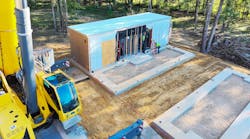Bridging the Gap: With Local Grids Stretched to the Limit, Data Centers Need a Plan for Reliable Supplemental Power
Data center energy demands, fueled by the relentless growth of Artificial Intelligence (AI) and cloud computing, are surging across the U.S., threatening to outpace the capacity of local power grids. This is prompting data center owners and developers, as well as utilities, to scramble for solutions.
Companies searching for their next data center locations need clarity around whether the facility can realistically support their power density and cooling requirements today and into the future. In all likelihood, some facilities will need to supplement or consider non-traditional power sources to handle these growing loads, especially during times of peak usage.
Data center owners, operators and users need to be aware of what viable supplemental energy sources exist, both immediately and into the future, to bridge the expected power gap. Below is a rundown of the various power sources that can help “top off” the grid during peak capacity times, with the pros and cons of each.
Natural gas
Supplemental natural gas turbines are the most accessible and robust bridge power solution. They are reliable and can be rapidly incorporated into a power plan, helping deliver necessary power within three to six months. They are also versatile, supporting base load or peak demand, and can transition to backup power after the bridging period. Of course, any form of natural gas is dependent on a firm gas supply, whether via pipeline or virtual delivery, but in the near term it remains a scalable and economically viable option while other, perhaps cleaner, power technologies mature in the market.
Battery storage
Battery storage acts best as a peak power solution, charging during low grid demand (at a lower cost) and discharging during peak utility constraints. This storage is particularly helpful for data centers' slow and steady flat load profiles, which typically don’t experience sudden power spikes. Batteries also provide grid support by reducing the power drawn from the grid during peak periods. This flexibility helps provide overall grid stability and reduces the chances of sudden disruptions to data centers.
Fuel cells
Fuel cells are electrochemical devices that convert the chemical energy of a fuel source, such as natural gas, directly into electricity without the need for combustion. Several high-profile projects have showcased the efficiency and reliability of natural gas fuel cells as a low-emissions alternative to combustion-based power. The technology is financially competitive with other power-bridging options, particularly in high-priced natural gas markets. Implementation rates are quickly increasing, making this a technology to watch. Fuel cells have been installed at projects exceeding 100 MW, however, they are most commonly found at data centers under 50 MW.
Solar/wind power
Solar and wind’s inherently intermittent and inconsistent output means they can’t be relied on as a bridge power source for data centers. However, these clean energy sources can support grid resilience and offset peak power demands by serving as complementing power sources for existing substations.
Small modular nuclear reactors
Though promising as a future power source, small modular nuclear reactors (SMRs) are not entirely competitive for bridge power today because of their long development and government approval timelines, not to mention their high price tag. However, many industry experts expect SMRs to reach commercial viability in five to 10 years, making them potential candidates for both bridge and grid power over the long term.
Diesel generators
Diesel generators, like natural gas, deliver fast, consistent power for data centers. Despite being less environmentally friendly than other solutions, diesel’s established supply chains and operational reliability makes diesel generators a dependable choice for short-term power needs.
Factoring power into your right data center location
Choosing the right data center location is critical for ensuring smooth operations and minimizing business disruptions. Beyond factors like connectivity and security, a crucial consideration is the site's power infrastructure. For data center occupiers and colocation providers, a reliable and robust power supply is paramount.
It’s important to evaluate all options before shortlisting your top choices. During the site selection process, here are a few of the key considerations to watch for regarding power:
- Grid reliability:
- What are the redundancy protections in place to ensure minimal downtime/disruptions?
- How easily accessible is the colocation or other facility to the power grid? Is it reliable and capable enough to support the facility’s power needs?
- How frequent and lengthy are power outages in the area, if any?
- Access to renewable energy:
- Does the facility have access to renewable energy sources (e.g. wind, solar) that can help lessen the environmental impact of the facility?
- Infrastructure capacity:
- Can the existing power grid handle the data center's projected power demands?
- Can the facility accommodate future data center expansion?
- Regulatory environment:
- What local regulations govern power grid access and backup power systems? E.g. permits, technical specifications
- Are there local regulations impacting data center power sourcing options? E.g. energy efficiency standards, power purchase agreements (or PPAs).
With so much at stake in terms of both short- and long-term data storage, the success of any location is hyper-dependent on the right power strategy – one that sees the macro trends but also understands what’s happening regionally and accounts for unique latency needs and other specific concerns.
For help building and executing a smart data center strategy, connect with a JLL expert to find the right location, with reliable power solutions, today.
About the Author

Andrew Batson
Andrew Batson is the Head of Americas Data Center Research at JLL. In this role, Andrew delivers insights and analytics to clients and JLL’s leadership team. Deliverables include sector analysis, insights on industry trends, forecasting, benchmarking, market sizing, portfolio analytics and market share analysis. Andrew has 16 years of experience in commercial real estate and related industries.




